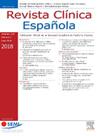PET/MRI对FDG PET/CT成像中发现的甲状腺结节良性和恶性的区别的贡献
IF 1.7
4区 医学
Q2 MEDICINE, GENERAL & INTERNAL
引用次数: 0
摘要
简介和目的在接受FDG PET/CT成像进行分期或治疗反应评估的肿瘤患者中经常观察到甲状腺偶发瘤。本研究旨在探讨PET/MRI测量的SUVmax和ADC值在区分良性和恶性甲状腺结节中的应用。材料与方法选择108例患者,其中女性72例,男性36例;平均年龄54±12岁),接受常规肿瘤FDG PET/CT扫描进行分期或治疗反应评估,结节大小大于1cm。全身PET/CT扫描后进行单床颈部PET/MRI扫描。测量SUVmax值,并使用b因子为50和1000 s/mm2的DWI创建ADC图。SUVmax和ADC值与FNAC结果相关。结果fnac结果显示,108例患者中良性结节76例(70.4%),恶性结节32例(29.6%)。恶性结节的平均SUVmax明显高于良性结节(10.6±8.3 vs. 5.94±5.2;术;措施)。同样,恶性结节的平均ADC值低于良性结节(1.4±0.6 × 10-3 mm2/s vs 1.8±0.4 × 10-3 mm2/s);术;措施)。FNAC结果与平均SUVmax呈显著的弱相关(r = 0.335),与平均ADC值呈显著的弱负相关(r = - 0.355)。SUVmax的临界值为6,ADC的临界值为1.56 × 10-3 mm2/s, SUVmax的敏感性、特异性和准确性分别为68.7、73.6和72.1%,而ADC的敏感性、特异性和准确性分别为71.8、69.7和70.4%。PET/MRI系统的相对灵敏度、特异性、准确性、PPV和NPV分别为90.62%、51.32%、62.96%、43.94%和92.86%。结论本研究是文献中首次探索使用FDG PET/MRI这种单次停止装置来区分高灵敏度和NPV的甲状腺结节良恶性。本文章由计算机程序翻译,如有差异,请以英文原文为准。
La contribución del PET/MRI en la diferenciación entre nódulos benignos y malignos en incidentalomas tiroideos detectados en imágenes FDG PET/CT
Introduction and objectives
Incidentalomas of the thyroid gland are frequently observed in oncological patients undergoing FDG PET/CT imaging for staging or treatment response assessment. This study aims to investigate the utility of SUVmax and ADC values measured by PET/MRI in distinguishing between benign and malignant thyroid nodules.
Materials and methods
We selected 108 patients (72 females, 36 males; mean age 54 ± 12 years) who underwent routine oncological FDG PET/CT scans for staging or treatment response assessment, with nodule sizes greater than 1 cm. A one-bed neck PET/MRI scan followed the whole-body PET/CT. SUVmax values were measured, and ADC maps were created using DWI with b factors of 50 and 1000 s/mm2. SUVmax and ADC values were correlated with FNAC results.
Results
FNAC results revealed 76 (70.4%) benign and 32 (29.6%) malignant nodules among the 108 patients. The mean SUVmax of malignant nodules was significantly higher than that of benign nodules (10.6 ± 8.3 vs. 5.94 ± 5.2; P<.001). Similarly, the mean ADC value was lower in malignant nodules compared to benign ones (1.4 ± 0.6 × 10-3 mm2/s vs. 1.8 ± 0.4 × 10-3 mm2/s; P<.001). A significant but weak correlation was found between FNAC results and mean SUVmax (r = 0.335), as well as a significant weak negative correlation with mean ADC values (r = −0.355). Using a cut-off value of 6 for SUVmax and 1.56 × 10-3 mm2/s for ADC, the sensitivity, specificity, and accuracy for SUVmax were 68.7, 73.6, and 72.1%, respectively, while for ADC, they were 71.8, 69.7, and 70.4%, respectively. The PET/MRI system demonstrated a relative sensitivity, specificity, accuracy, PPV, and NPV of 90.62, 51.32, 62.96, 43.94, and 92.86%.
Conclusion
This study is one of the first in the literature to explore the use of FDG PET/MRI, a single-stop device, in distinguishing between benign and malignant thyroid nodules with high sensitivity and NPV.
.
求助全文
通过发布文献求助,成功后即可免费获取论文全文。
去求助
来源期刊

Revista clinica espanola
医学-医学:内科
CiteScore
4.40
自引率
6.90%
发文量
73
审稿时长
28 days
期刊介绍:
Revista Clínica Española published its first issue in 1940 and is the body of expression of the Spanish Society of Internal Medicine (SEMI).
The journal fully endorses the goals of updating knowledge and facilitating the acquisition of key developments in internal medicine applied to clinical practice. Revista Clínica Española is subject to a thorough double blind review of the received articles written in Spanish or English. Nine issues are published each year, including mostly originals, reviews and consensus documents.
 求助内容:
求助内容: 应助结果提醒方式:
应助结果提醒方式:


